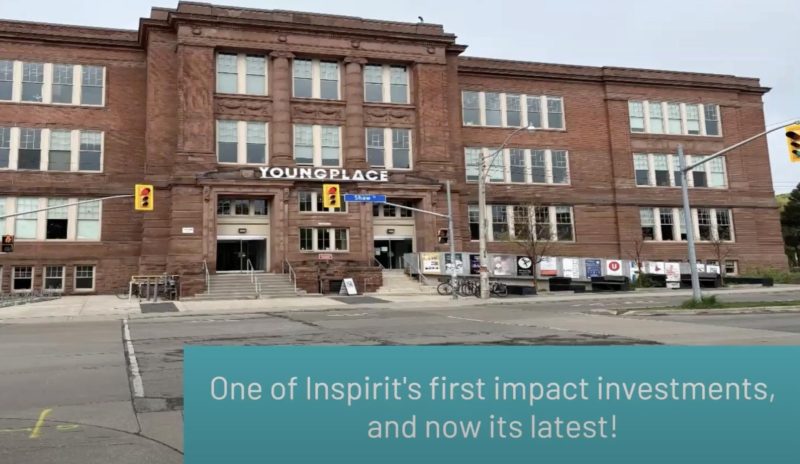
As part of the Blended Finance Webinar Series, a collaboration between Spring, Ontario Trillium Foundation, and Thrive Impact Fund, Kristi Fairholm Mader, Managing Director of Thrive, interviewed Christopher Lee, Director of Programming at Inspirit Foundation. Together, they explored a real-world example of how blended finance and catalytic capital helped preserve critical arts and culture spaces in Toronto.
A Cultural Space in Jeapody
In 2023, 13 arts-focused units at Toronto’s Young Place went into receivership after the developer declared bankruptcy. The space, originally an old school converted into a cultural hub, was home to over 30 tenants. As Lee described, “There were tenants there that were, again, individual artists and nonprofit organizations that were suddenly facing a pretty bleak future.”
Lee and his colleagues at Inspirit Foundation initially considered buying all the units. “Our initial thought was that maybe we could flip them, sell them to nonprofits at a decent rate, but really keep them out of the speculative investment market.” But they quickly realized they lacked the capital for such a large purchase.
A Turn Toward Blended Finance
Blended finance became essential to making a smaller-scale intervention possible. “We worked with tenants to begin to source capital,” Lee explained, describing an 18-month effort to secure loans and grants that would allow some tenants to buy their own spaces. But two tenants, Paperhouse Studio and Toronto Potters Collective, weren’t in a position to buy.
That’s when Inspirit shifted focus: “We weren’t interested in being landlords. We weren’t interested in flipping the units for profit.” Instead, they began talks with the newly formed Cultural and Community Spaces Trust (CCST), a volunteer-run land trust in Toronto.
A Unique Deal Structure
Working with CCST, Inspirit developed a blended finance structure that prioritized affordability and long-term community stewardship. This flexible revenue-based repayment model gave CCST breathing room. “If you’re carrying debt and are stuck with payments every month and you don’t have the revenue coming in, you can quickly fall into a pretty scary cycle,” Lee noted. The structure also included covenants and title restrictions ensuring the spaces would remain in cultural use.
The City of Toronto played a key role, offering grants to the tenants. Inspirit subtracted those grant amounts from the final sales price to make the units even more affordable: “We decided to subtract that grant amount from the sales purchase to CCST.”
First Cultural Land Trust Purchase in Canada
This wasn’t just a success story, it was a precedent-setting one. “This was actually the first cultural land trust purchase in Canada,” Lee confirmed. “We thought this was a great way to do something new and catalytic in this country.”
He continued, “Paperhouse Studio and Toronto Potters both got to keep their homes and to continue to serve their communities… and they got to do it at the same lease terms. We just rolled over the lease.”
What Made It Catalytic?
Inspirit describes this as catalytic capital: “We’re a public foundation, and we have a mandate to work in service of the public good,” Lee said. “We have an investment strategy that is focused on 100% impact.”
The decision to offer zero percent interest was grounded in that strategy: “We actually allocate a certain percentage of our portfolio towards 0% investments… Some people might say, ‘Well, that’s not an investment at all.’ But I’d say, actually, it is, because we’re not looking just at the financial returns, we’re looking at the social and environmental returns.”
What made this catalytic capital stand out?
- It came early. “We like to be early movers,” said Lee.
- It filled a gap. “It’s allowing a small organization without a track record to make the purchase that can hopefully lead to more purchases in the future.”
- It enabled other capital. “Inspirit’s money was used as leverage… That got people’s ears perked.”
- It wasn’t typical. “This is not a typical deal for Inspirit. We’re not generally in the real estate business.”
Fairholm Mader noted, “Sometimes catalytic capital is the first in. It’s making that something is worthwhile and putting your reputation behind it… Sometimes that gap is exactly these kinds of formations.”
Blended Finance in Practice
The approach blended grants (from the City of Toronto), concessionary capital (from Inspirit), and long-term community ownership (via CCST). As Fairholm Mader explained, “Blended capital is bringing together different types of capital in a deal… to provide a whole capital mix to help bring projects over the line.”
Lee emphasized how this aligned with Inspirit’s broader investment philosophy: “One of our key things is around investing in community infrastructure and thinking about conditions that contribute to pluralism. Access to arts and culture is one of them.”
The repayment model was also essential to making the deal work: “CCST said that this was the most important piece of this deal from their perspective.”
“The Speed of Trust”
Building the deal wasn’t without risk or urgency. “When it came down to it, the actual deal had to happen very quickly. We had a two-week window to put bids on,” Lee recalled. “We had to do this off cycle”… and CCST had to move quickly too.
Trust was the glue: the group spent time together, met everyone in the building and ensured that the process and outcome were values-aligned.
Canada’s First Cultural Land Trust Purchase
Inspirit’s investment enabled the preservation of cultural space, helped launch the first cultural land trust purchase in Canada, and showcased what’s possible with blended finance. As Lee summed it up:
“Even though we sometimes write the smaller grants than others, and I’d say the same applies for our investments, they can be quite important. They open up doors. They have often outsized impacts.”

